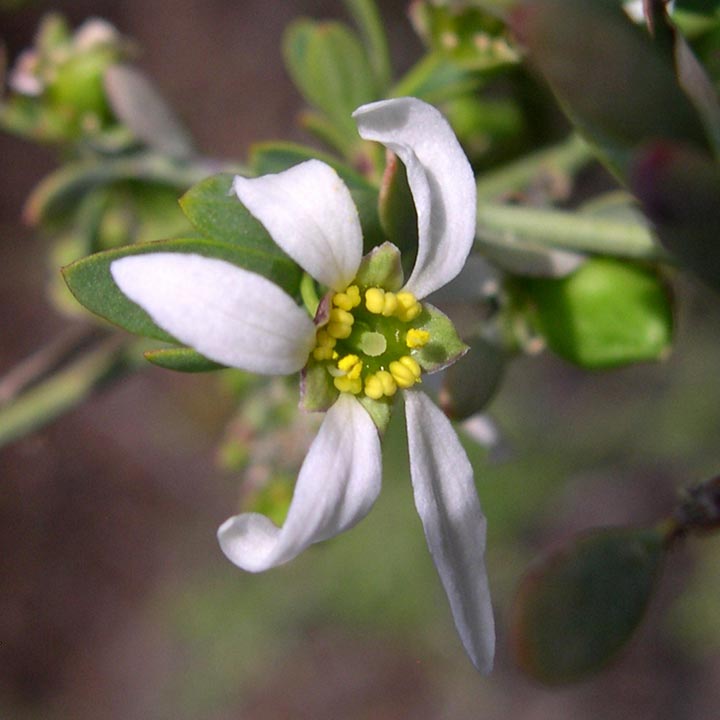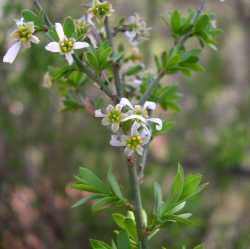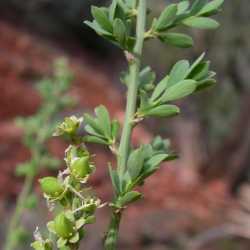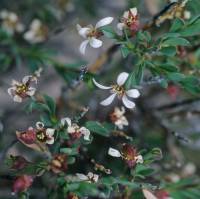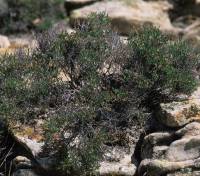|
|
|
|
Family: Crossosomataceae
spiny greasebush
|
Plant: shrubs, intricately or divaricately branched, spinescent Leaves: distant; apices not spine tipped; stipules absent or if present minute, subulate, 0.1-0.9 mm long, attached to the persistent glandular petiole base Flowers: solitary, axillary or terminal on short shoots; glandular disk lining the hypanthium; sepals (4-)5(-6), lanceolate, ovate, or circular, 4-5 mm long, persistent; petals (4-)5(-6), white, narrowly lanceolate to broadly oblanceolate, deciduous, 6-10 mm long; stamens 6-10; carpels 1(-3), sessile; stigma discoid Fruit: FRUITS striated; SEEDS 1-2 with a circular, irregular, whitish aril Misc: on limestone, canyons, hillsides, cliffs; 850-2200 m.; Apr-May REFERENCES: Mason, Charles T., Jr. Crossosomataceae. . Ariz.-Nev. Acad. Sci. 26(1):2 VPAP (Mason 1992), Heil et al. 2013 Common Name: spiny greasebush Duration: Perennial Nativity: Native Lifeform: Subshrub General: Intricately branched shrubs to 2 m tall but usually shorter; branches spine-tipped; young branches green, becoming orange-tan to gray with age. Leaves: Alternate along the young green branchlets, on very short petioles up to 2 mm long; blades oblanceolate, 5-10 mm long, gray-green and glaucous. Leaves typically appear when the plant begins flowering. Flowers: White and solitary in leaf axils, on pedicels 1-5 mm long; sepals 5, white, 1-2 mm long, with hyaline (papery) margins; petals 5, white, oblanceolate to linear, 2-7 mm long. Fruits: Follicles (seed pods that split open along one suture line) 3-6 mm long, longitudinally ribbed, green or brown; containing a single round seed, 2-3 mm wide, partly enclosed by a fimbriate aril. Ecology: Found on limestone in canyons, on hillsides and cliffs in desert scrub, grasslands, chaparral and juniper woodlands, from 3,000-7,000 ft (914-2134 m); flowers March-May. Distribution: w U.S. from WA to TX; n MX. Notes: Occurs on calcareous soils and is distinguished by being a low growing shrub with many densely overlapping spine-tipped branches; leaves and young twigs that appear slightly waxy and grayish-green; and the flowers with white, quickly deciduous petals. Especially distinct are the red (sometimes white) glandular bases of the petioles which are persistent after leaves fall, appearing as dark spots or bumps along the stems. Ethnobotany: Unknown Etymology: From the Greek glossa meaning tongue and petalon meaning petal, referring to the shape of the petals; spinescens refers to the branches which become spinescent. Synonyms: None Editor: AHazelton 2017 |


